- 10 Jan 2024
- 12 Minutes to read
-
Print
-
DarkLight
RiskIQ Enrichment
- Updated on 10 Jan 2024
- 12 Minutes to read
-
Print
-
DarkLight
As of ThreatConnect 7.8.1, the RiskIQ built-in enrichment service is no longer available, because Microsoft® has discontinued the RiskIQ Community Edition.
Enabling the RiskIQ Enrichment
Before you can retrieve data from RiskIQ® for Host Indicators, a System Administrator must first enable and configure the RiskIQ enrichment in ThreatConnect.
- Log into ThreatConnect with a System Administrator account.
- On the top navigation bar, hover over Settings
 and select System Settings. The System Settings screen will be displayed with the Settings tab selected.
and select System Settings. The System Settings screen will be displayed with the Settings tab selected. - Select the Indicators tab. The Indicators screen will be displayed.
- Click Enrichment Tools in the menu on the left side of the Indicators screen. The Enrichment Tools screen will be displayed.
- Click Edit
 in the Options column for RiskIQ. The Edit Vendor window will be displayed (Figure 1).
in the Options column for RiskIQ. The Edit Vendor window will be displayed (Figure 1). 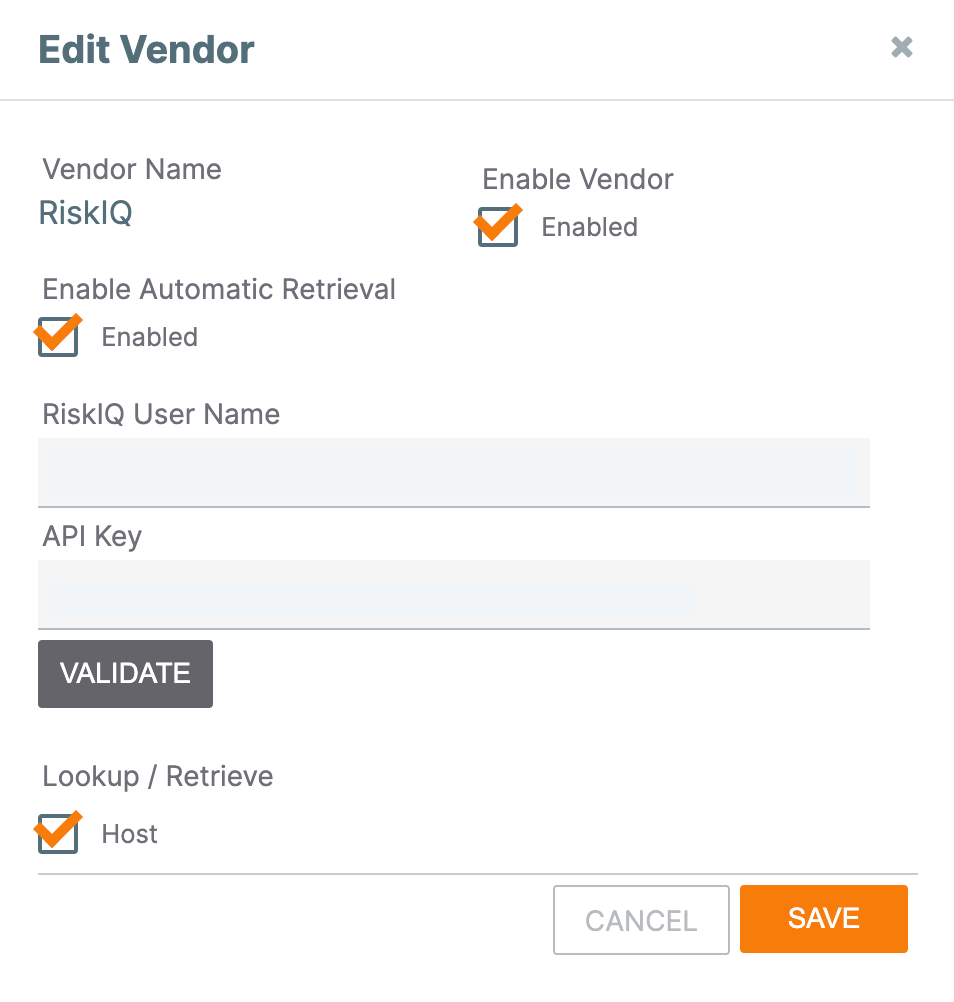
- Enable Vendor: Select this checkbox to enable RiskIQ.
- Enable Automatic Retrieval: Select this checkbox to enable automatic data retrieval for RiskIQ. If automatic data retrieval is enabled, RiskIQ data will automatically populate when a user clicks on an Indicator’s Enrichment tab for the first time. This checkbox is selected by default.
- RiskIQ User Name: Enter the username associated with the account that will be used to retrieve data from RiskIQ.
- API Key: Enter the API key that will be used to retrieve data from RiskIQ.
- VALIDATE: After entering the RiskIQ username and API key, click this button to validate them. If the username and API key are accepted, the VALIDATE button’s label will change to VALID, indicating that a valid username and API key have been entered. If the username or API key is not accepted, a message stating “User Name or API Key is invalid.” will be displayed at the top of the Edit Vendor window.
- Lookup/Retrieve: Select the Indicator type(s) for which to retrieve data from RiskIQ. The only available Indicator type is Host.
- Click the SAVE button.
When RiskIQ is enabled, a value of true will be displayed in the Enabled column for its entry on the Enrichment Tools screen.
Data Overview
The Overview section of the RiskIQ card (Figure 2) provides a summary of data retrieved from RiskIQ for a Host Indicator and the date and time the data were last retrieved.
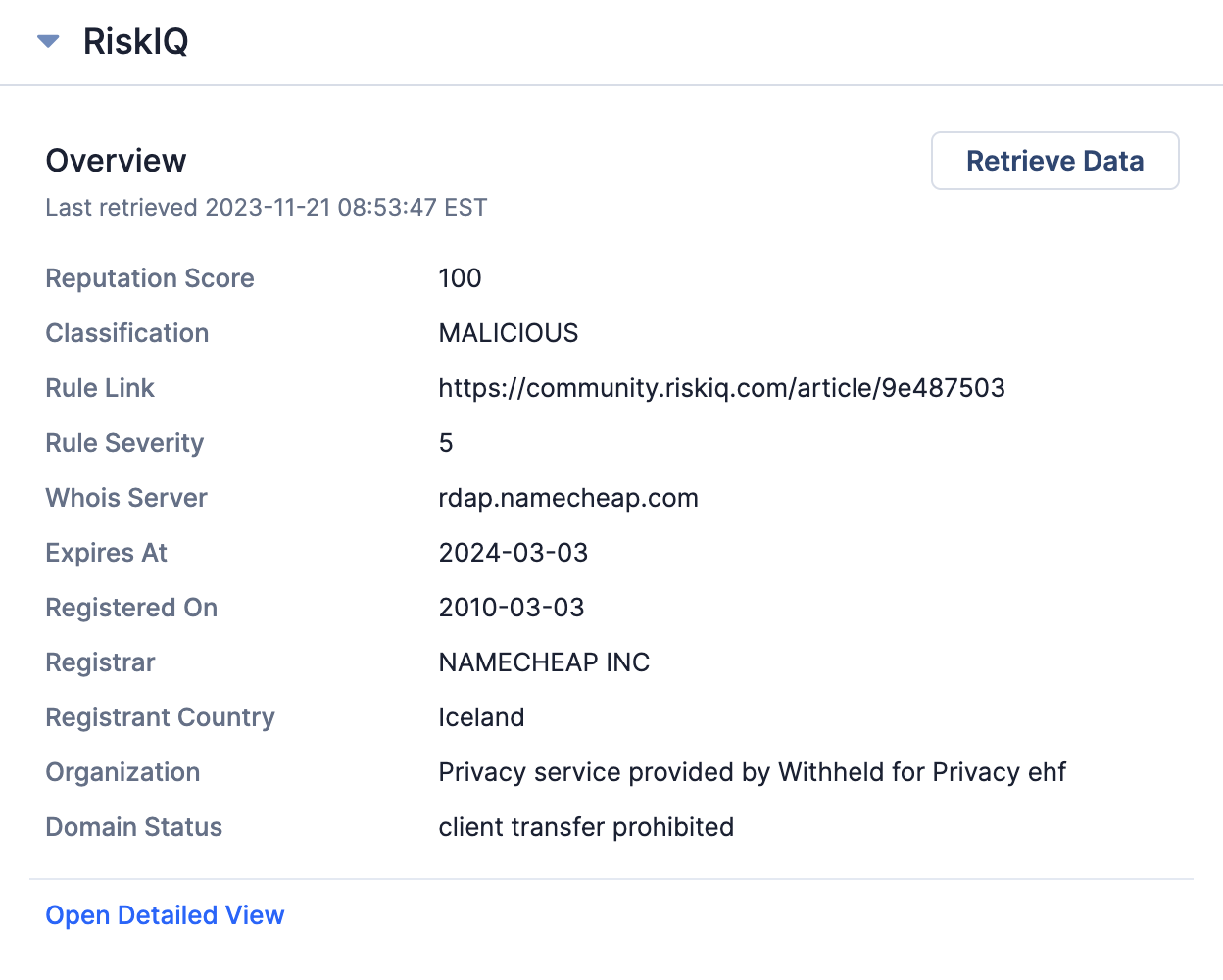
- Reputation Score: The reputation score for the Host.
- Classification: The classification level associated with the reputation score.
- Rule Link: A link to the rule with the highest severity that was used to determine the reputation score.
- Rule Severity: The severity of the rule listed in the Rule Link field.
- Whois Server: The server set up by the Host’s registrar to acquire up-to-date information about the Host.
- Expires At: The date when the registration will expire.
- Registered On: The date when the Host was registered.
- Registrar: The registrar for the Host’s registration.
- Registrant Country: The country in which the Host’s registrar resides.
- Organization: The organization that registered the Host.
- Domain Status: The current status of the Host.
RiskIQ Detailed View
Click the Open Detailed View link on the RiskIQ card to display the RiskIQ Detailed View drawer (Figure 3). This drawer displays cards with additional data retrieved from RiskIQ.
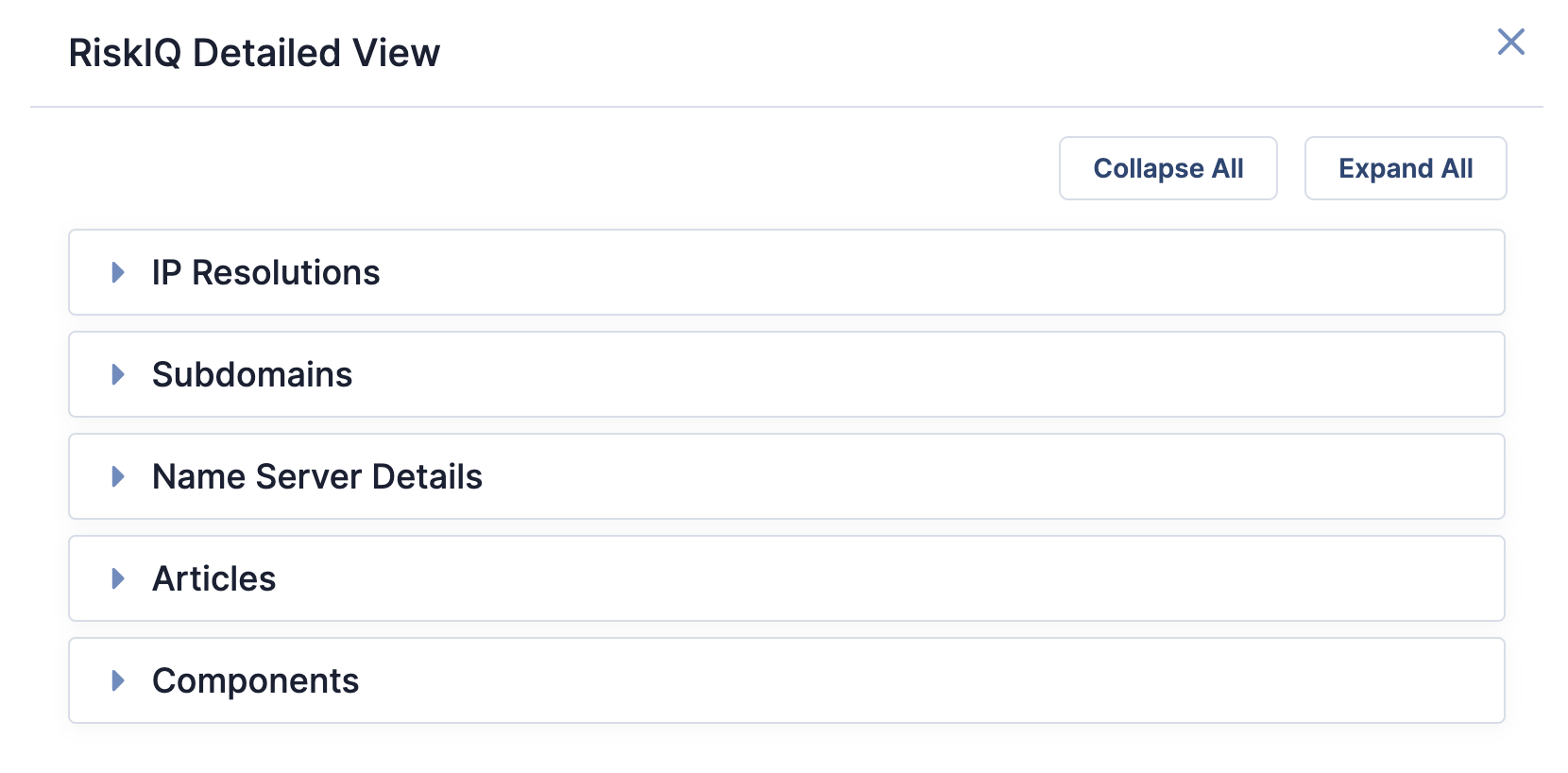
The cards displayed on the RiskIQ Detailed View drawer are collapsed by default. Click on a card to expand it and view its data. To collapse or expand all cards, click the Collapse All or Expand All button, respectively, at the top right of the drawer. Figure 4 shows the RiskIQ Detailed View drawer in Figure 3 with all available cards expanded.
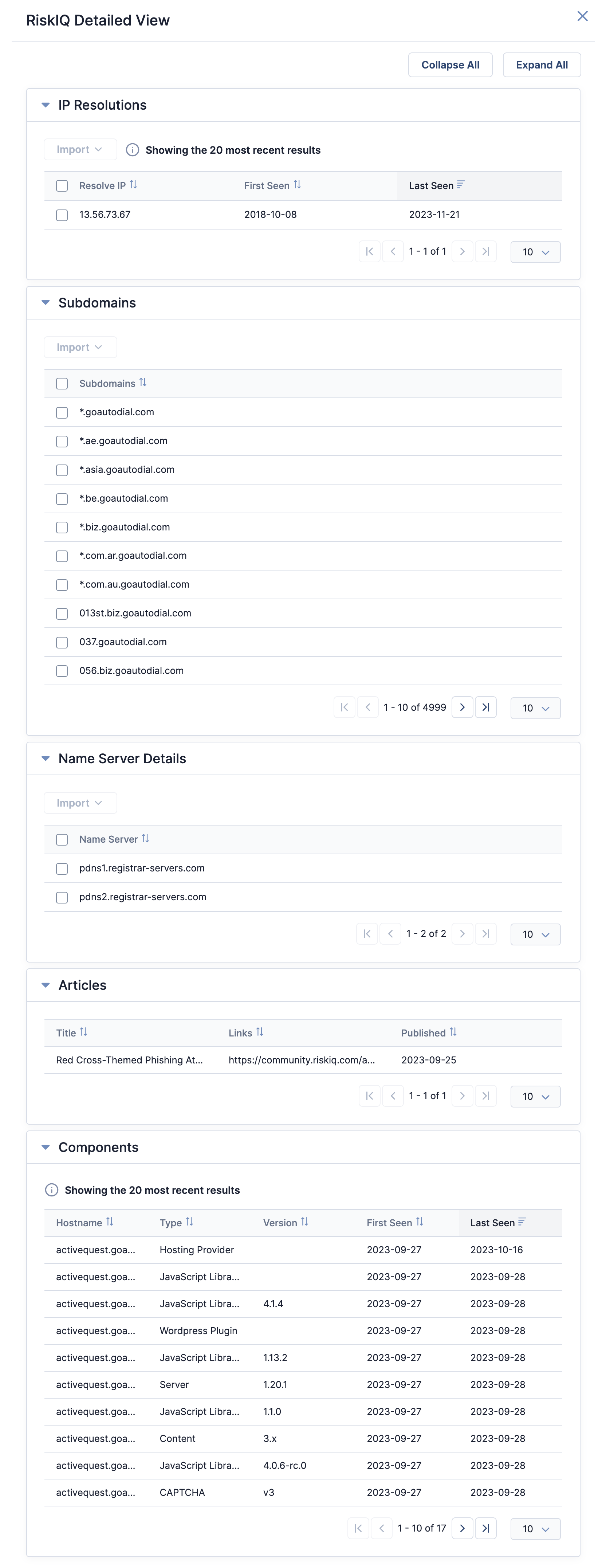
See Table 1 for a list of cards that may be displayed on the RiskIQ Detailed View drawer for a Host Indicator.
| Card Name | Description |
|---|---|
| Articles | This card displays details about RiskIQ articles related to the Host. |
| Components1 | This card displays information about the web components associated with the Host, including the component’s type, version, and first- and last-seen dates. |
| IP Resolutions1 | This card displays IP address resolutions for the Host and the dates when each resolution was first and last seen. |
| Name Server Details | This card displays name servers associated with the Host. |
| Passive DNS Details1 | This card displays DNS records associated with the Host and each record’s type and first- and last-seen dates. |
| SSL Certificates1 | This card displays details about the SSL certificates associated with the Host, including the certificate’s SHA1 algorithm hash, the certificate’s Common Name (CN), and the dates when the certificate was issued and will expire. |
| Subdomains | This card displays subdomains associated with the Host. |
1 The maximum number of results that may be displayed on this card is 20.
Importing Indicators From RiskIQ Into ThreatConnect
You may import all or a subset of the Indicators displayed on the IP Resolutions, Name Server Details, Passive DNS Details, and Subdomains cards into ThreatConnect and associate them to a new or existing Group. You may also import Indicators displayed on the IP Resolutions card into ThreatConnect and associate them directly to the enriched Indicator (i.e., the Host Indicator whose Details screen you are viewing) via a custom association.
- On the RiskIQ Detailed View drawer, expand one of the following cards to display a table containing Indicators retrieved from RiskIQ that are related to the enriched Host Indicator (Figure 4):
- IP Resolutions: The Indicators on this card will be imported as Address Indicators.
- Name Server Details: The Indicators on this card will be imported as Host Indicators.
- Passive DNS Details: The Indicators on this card will be imported as Host Indicators.
- Subdomains: The Indicators on this card will be imported as Host Indicators.
- On the expanded card, select the checkbox for each Indicator you want to import into ThreatConnect. To select all Indicators displayed on the current page in the table, select the checkbox in the table’s header.ImportantIf a selected Indicator already exists in the ThreatConnect owner into which you are importing data, that copy of the Indicator will be updated based on the information entered and options configured during the import.
- Click the Import dropdown at the top left of the expanded card and select one of the following import options (Figure 5). Further instruction on each import option is available in the following subsections.

- To New Group: Select this option to import the selected Indicators and associate them to a new Group created during the import.
- To Existing Group: Select this option to import the selected Indicators and associate them to an existing Group.
- As an Indicator: Select this option to import the selected Indicators and associate them directly to the enriched Indicator via a custom association.
Importing Indicators Into a New Group
- Follow Steps 1–3 in the “Importing Indicators From RiskIQ Into ThreatConnect” section and select To New Group from the Import dropdown. The Details section of the Create screen will be displayed (Figure 6).
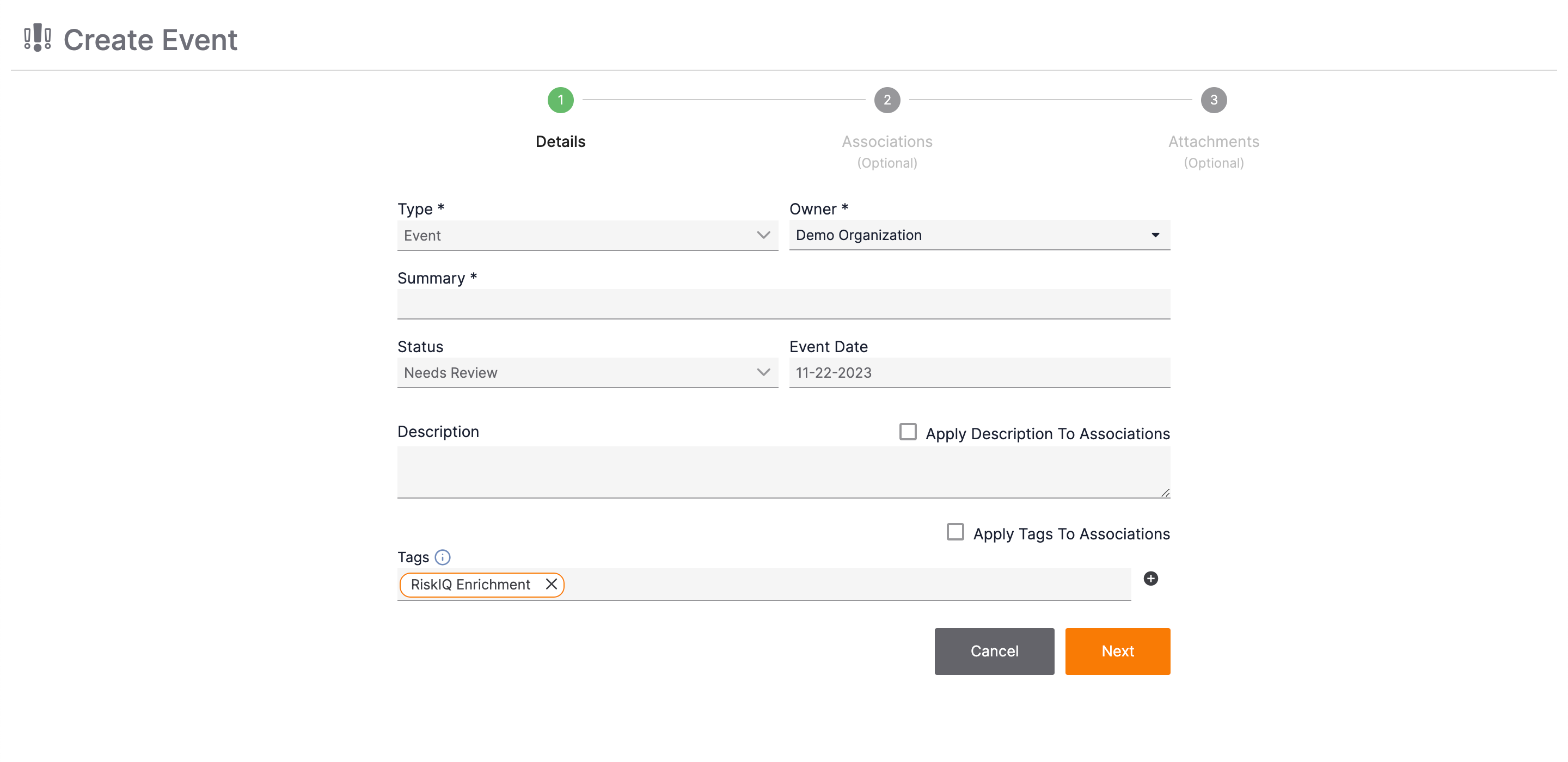
- Type: By default, Event is selected. If desired, select another Group type from the dropdown.
- Fill out all remaining fields on the Details section. For descriptions of each field available on this screen, see the “Creating a Group” section of Create.NoteBy default, a RiskIQ Enrichment Tag will be applied in the Tags field. You can remove this Tag, if desired.ImportantIf you select the Apply Tags to Associations checkbox, it is recommended that you remove the RiskIQ Enrichment Tag so that this Tag does not get applied to the enriched Indicator (that is, the Indicator whose Enrichment tab from which you are importing RiskIQ data), as the enriched Indicator will be added as an association to the new Group. Alternatively, if you want the RiskIQ Enrichment Tag to be applied to all associations except the enriched Indicator, you can select the Apply Tags to Associations checkbox, retain the RiskIQ Enrichment Tag, and then, after completing the import, navigate to the Overview tab of the Details screen for the enriched Indicator and remove the Tag manually.
- Click the Next button.NoteThe Save button is available only on the Associations and Attachments sections.
- The Associations section will be displayed (Figure 7).
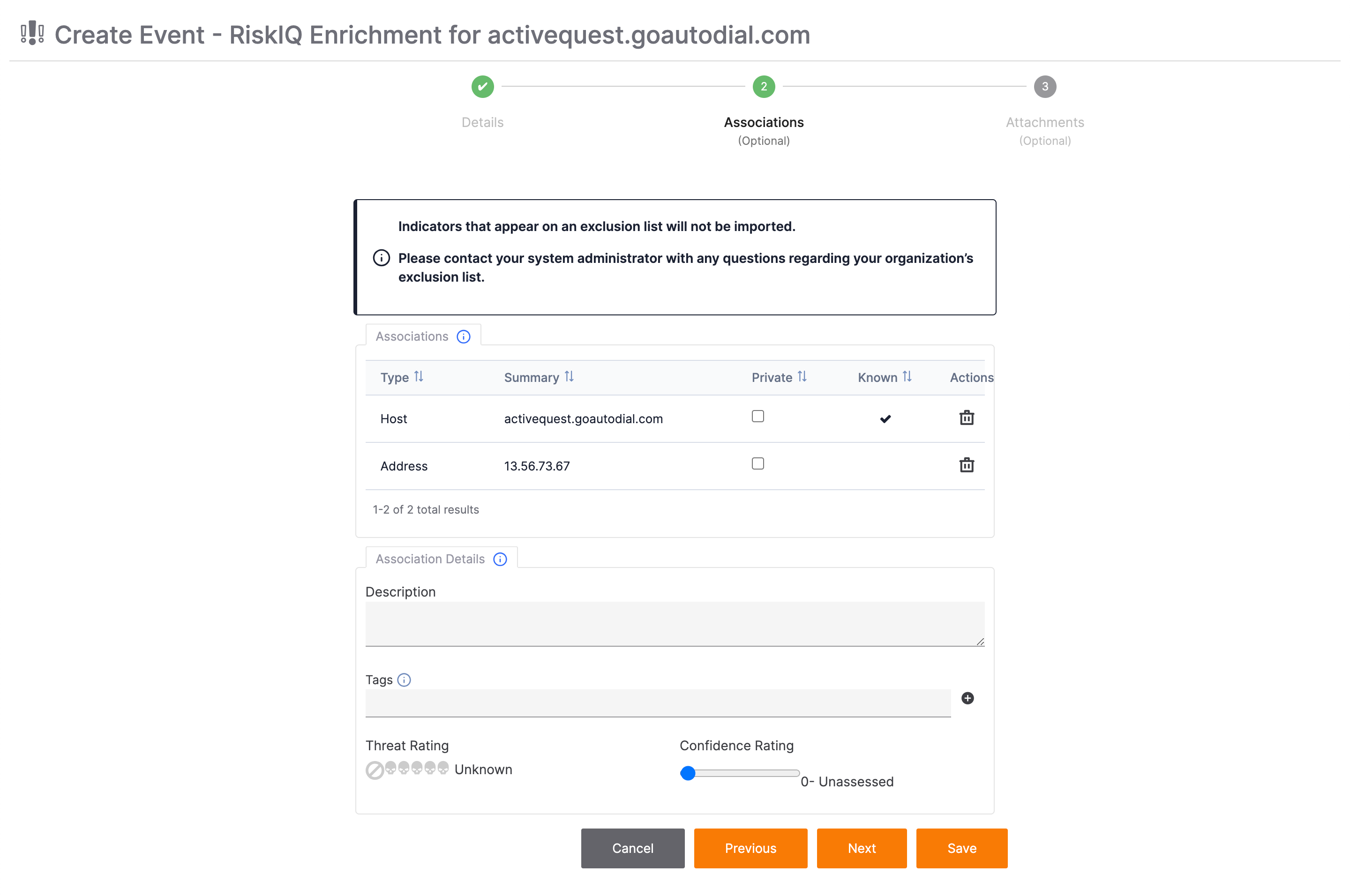 NoteA checkmark in the Known column indicates that the corresponding Indicator exists in at least one owner to which you have access.
NoteA checkmark in the Known column indicates that the corresponding Indicator exists in at least one owner to which you have access.- Associations: The selected Indicator(s), as well as the enriched Host Indicator, will be displayed in the Associations card. In this card, you can complete the following actions:
- Private: To mark an Indicator as private, select the corresponding checkbox in the Private column. This column will be displayed only if your System Administrator has enabled private Indicators.
- Actions: To remove an Indicator from the list of Indicators being imported, click Delete
 .
.
- Association Details: In the Associations Details card, you can fill out the following information, which will be applied to all Indicators being associated to the Group:ImportantAll information added in this section will be applied to the enriched Indicator (that is, the Indicator whose Enrichment tab from which you are importing RiskIQ data), because the enriched Indicator is always added as an association to the new Group, along with the Indicators selected on the card on the RiskIQ Detailed View (Figure 5). If the enriched Indicator has a default Description, a Threat Rating, or a Confidence Rating and you enter a value for one of these fields, then that value will replace the existing value for the enriched Indicator. Tags entered in this section will be applied in addition to the enriched Indicator’s existing Tags.
- Description: Enter a default Description for the Indicator(s).
- Tags: Enter one or more Tags to apply to the Indicator(s).
- Threat Rating: Use the skull icons to set the Threat Rating for the Indicator(s).
- Confidence Rating: Use the slider to set the Confidence Rating for the Indicator(s).
- Click the Next button.
- Associations: The selected Indicator(s), as well as the enriched Host Indicator, will be displayed in the Associations card. In this card, you can complete the following actions:
- The Attachments section will be displayed (Figure 8). Attachments is an optional section where you can attach related files to the Group.
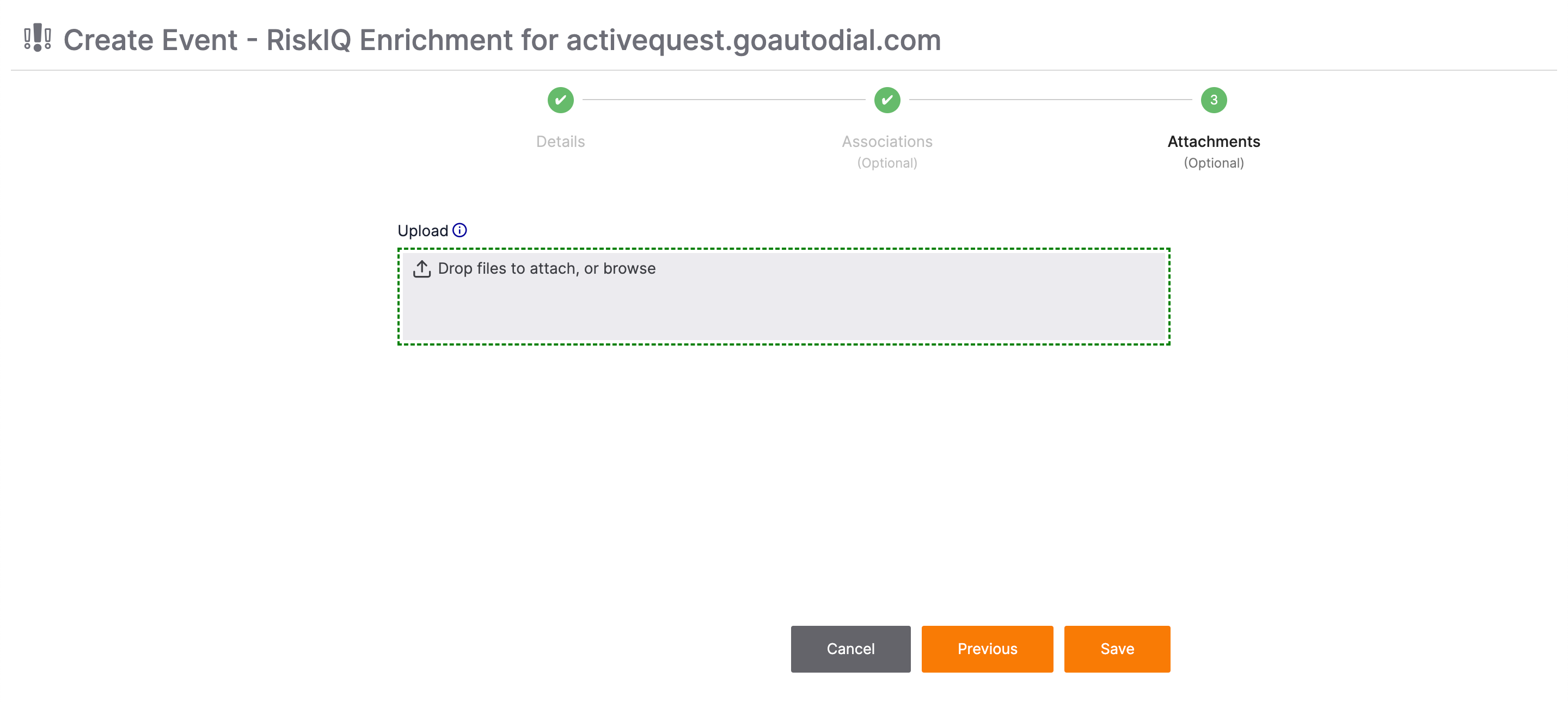
- Upload files for which Document Groups will be created and associated to the Group being created, if desired. After each file is uploaded, the filename will be displayed below the upload area, along with a checkbox labeled Add to Malware Vault. Leave this checkbox cleared unless you are uploading a malware file.
- Click the Save button.
The selected Indicator(s) will be imported into ThreatConnect and associated to the newly created Group, and the Group’s Details screen will be displayed. These Indicators will be displayed on the Indicators card of the Group’s Associations tab. You may also view these associations on the Associations card of the Group’s legacy Details screen, under the Associated Indicators section when the card is in table view.
Importing Indicators Into an Existing Group
- Follow Steps 1–3 in the “Importing Indicators From RiskIQ Into ThreatConnect” section and select To Existing Group from the Import dropdown. The Select Group section of the Import to Existing Group screen will be displayed (Figure 9).
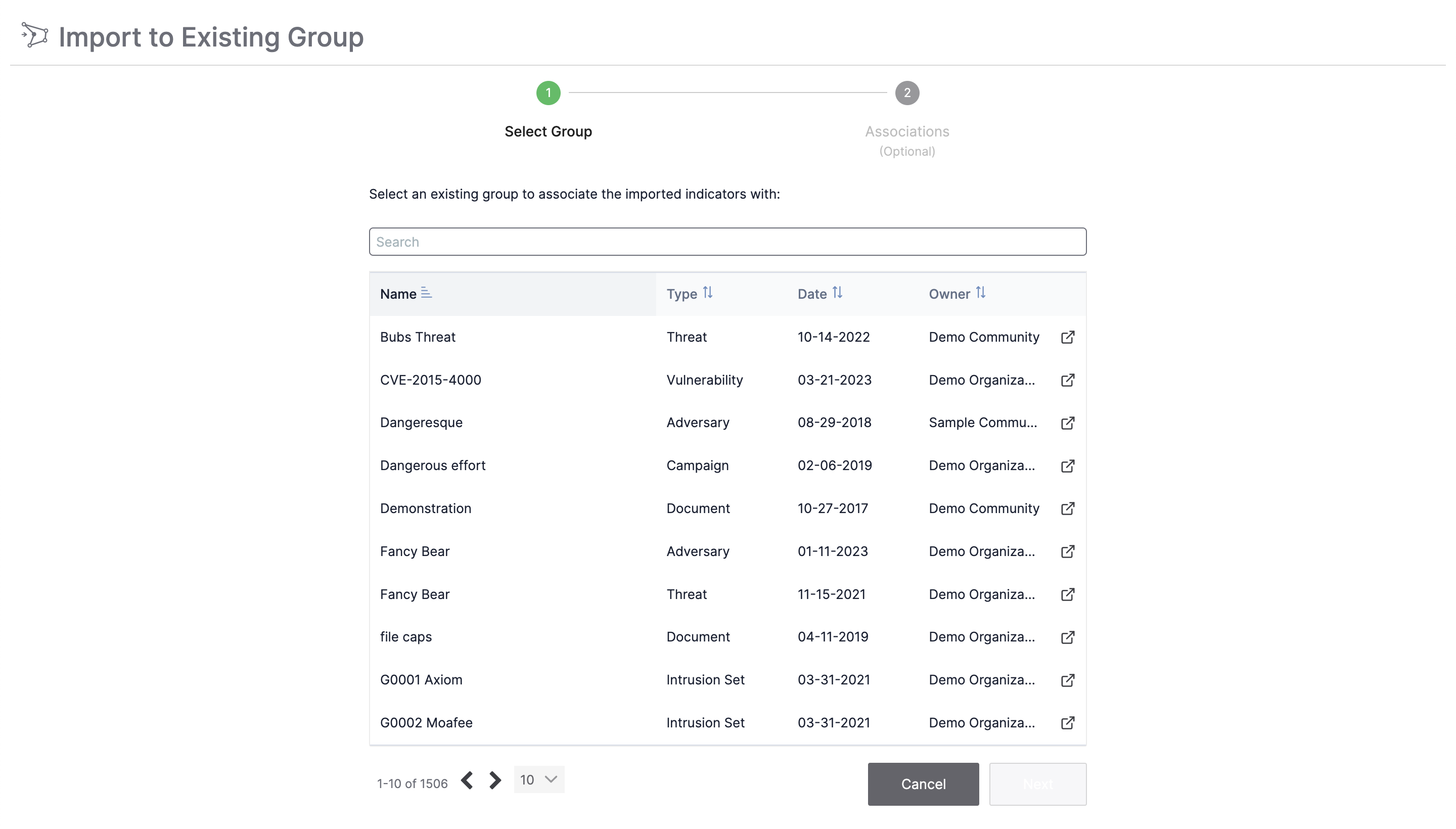
- Select the Group to which the selected Indicator(s), as well as the enriched Host Indicator, will be associated. To search for a Group, enter its name in the search bar above the table containing all Groups.
- To view a Group’s Details screen , click the Open in New Tab
 icon to the right of the Owner column.
icon to the right of the Owner column. - Click the Next button.
- The Associations section will be displayed (Figure 10).
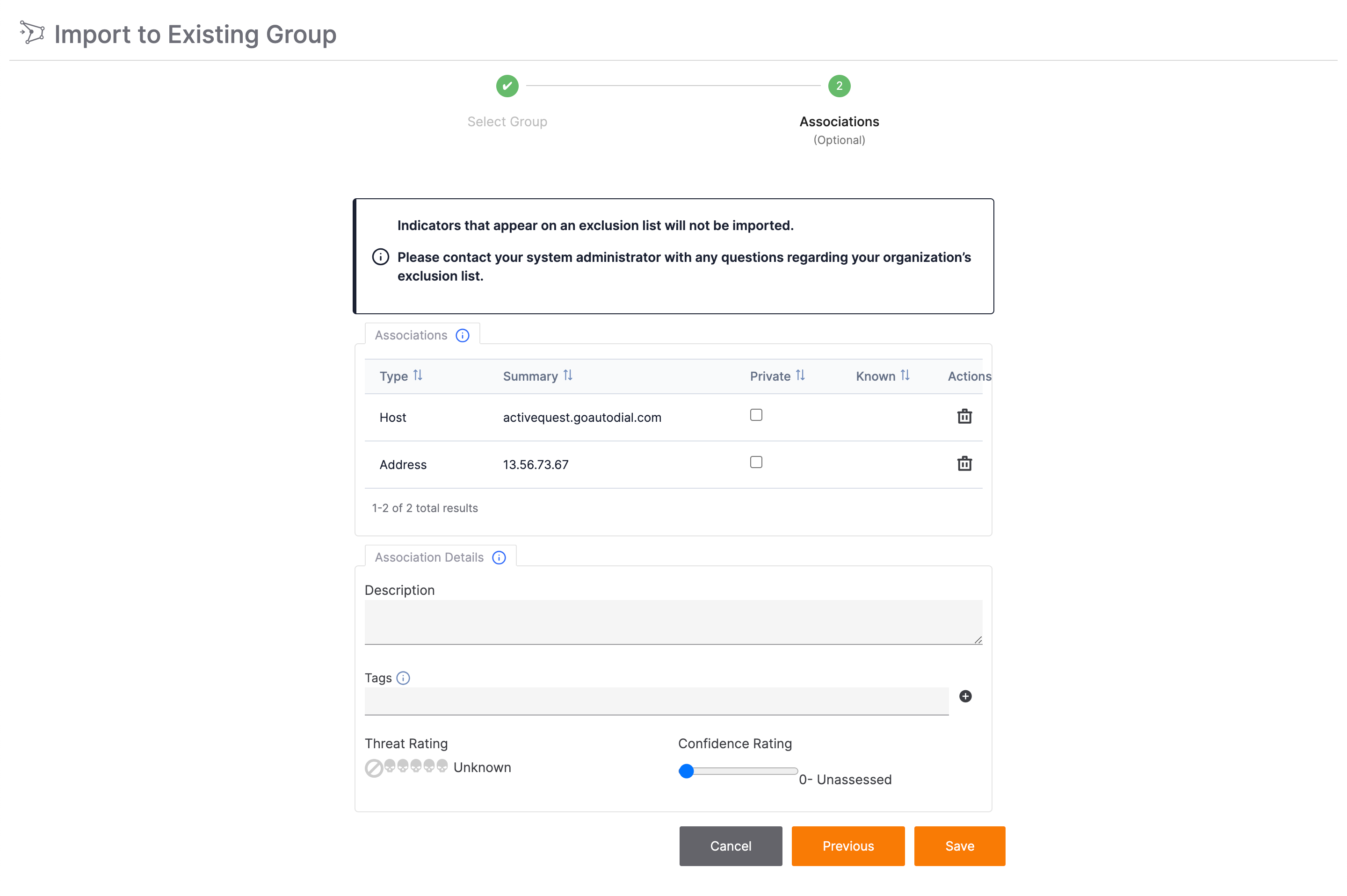 NoteA checkmark in the Known column indicates that the corresponding Indicator exists in at least one owner to which you have access.
NoteA checkmark in the Known column indicates that the corresponding Indicator exists in at least one owner to which you have access.- Associations: The selected Indicator(s), as well as the enriched Host Indicator, will be displayed in the Associations card. In this card, you can complete the following actions:
- Private: To mark an Indicator as private, select the corresponding checkbox in the Private column. This column will be displayed only if your System Administrator has enabled private Indicators.
- Actions: To remove an Indicator from the list of Indicators being imported, click Delete
 .
.
- Association Details: In the Associations Details card, you can fill out the following information, which will be applied to all Indicators being associated to the Group:ImportantAll information added in this section will be applied to the enriched Indicator (that is, the Indicator whose Enrichment tab from which you are importing RiskIQ data), because the enriched Indicator is always added as an association to the new Group, along with the Indicators selected on the card on the RiskIQ Detailed View (Figure 5). If the enriched Indicator has a default Description, a Threat Rating, or a Confidence Rating and you enter a value for one of these fields, then that value will replace the existing value for the enriched Indicator. Tags entered in this section will be applied in addition to the enriched Indicator’s existing Tags.
- Description: Enter a default Description for the Indicator(s).
- Tags: Enter one or more Tags to apply applied to the Indicator(s).
- Threat Rating: Use the skull icons to set the Threat Rating for the Indicator(s).
- Confidence Rating: Use the slider to set the Confidence Rating for the Indicator(s).
- Click the Save button.
- Associations: The selected Indicator(s), as well as the enriched Host Indicator, will be displayed in the Associations card. In this card, you can complete the following actions:
The selected Indicator(s) will be imported into ThreatConnect and associated to the existing Group, and the Group’s Details screen will be displayed. These Indicators will be displayed on the Indicators card of the Group’s Associations tab. You may also view these associations on the Associations card of the Group’s legacy Details screen, under the Associated Indicators section when the card is in table view.
Importing Indicators as Indicators
Follow Steps 1–3 in the “Importing Indicators From RiskIQ Into ThreatConnect” section and select As an Indicator from the Import dropdown. The Import Indicators window will be displayed (Figure 11).
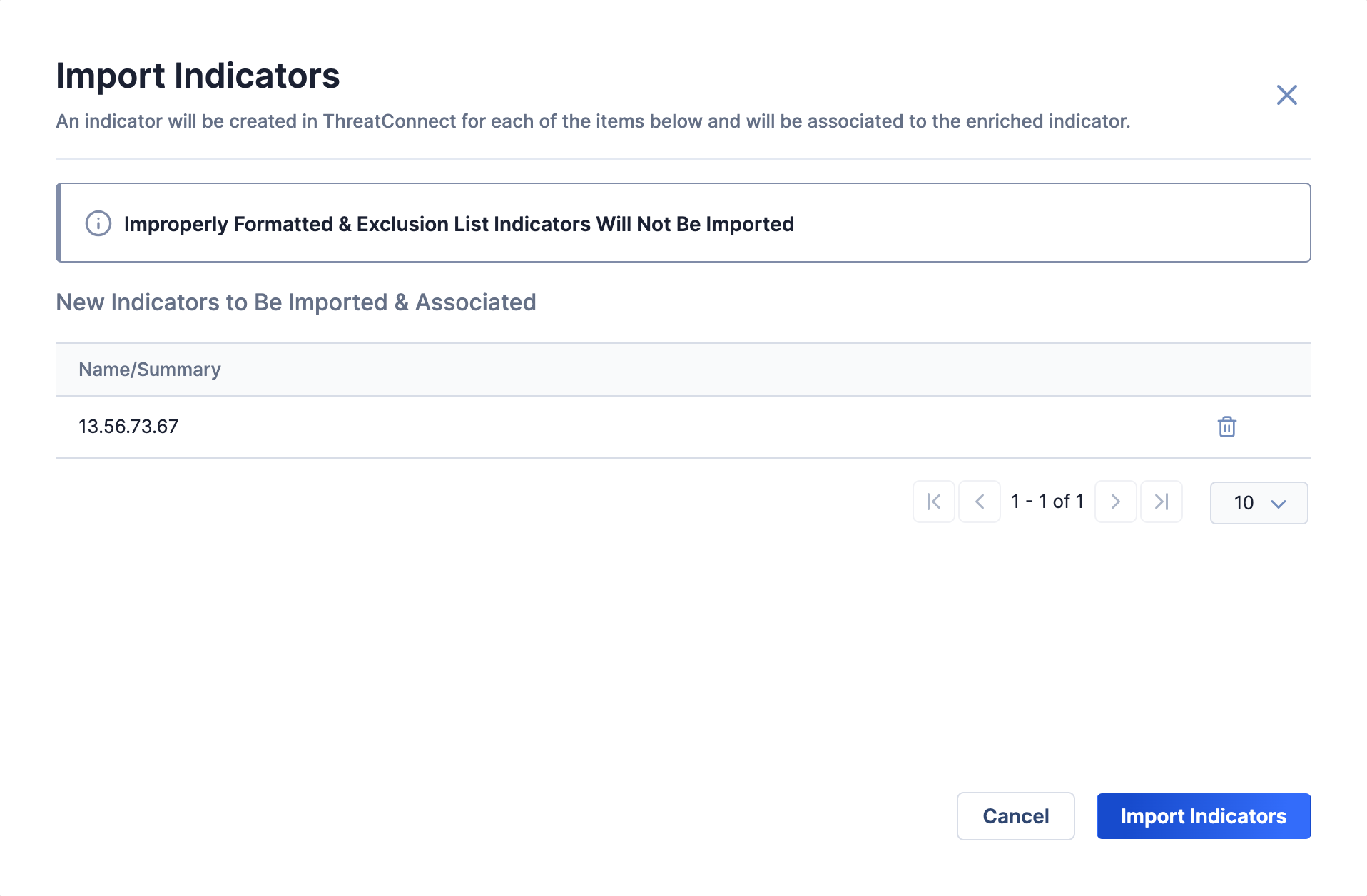
- New Indicators to be Imported & Associated: This section displays the Indicators that will be imported into ThreatConnect and associated directly to the enriched Indicator. To remove an Indicator from this list, click Delete
 .
. - Click the Import Indicators button.
The selected Indicator(s) will be imported into ThreatConnect and associated to the enriched Indicator, and the Associations tab of the enriched Indicator’s Details screen will be displayed. The associated Indicators will be displayed on the Indicators card of this tab. You may also view these associations on the Associations card of the enriched Indicator’s legacy Details screen, under the Associated Indicators section when the card is in table view.
Retrieving Data Manually
When you click on a Host Indicator’s Enrichment tab for the first time, data will be retrieved from RiskIQ automatically if your System Administrator has enabled automatic data retrieval for RiskIQ. Otherwise, a message stating that “Automatic Data Retrieval has been disabled by the System Administrator” will be displayed on the card, and you will need to click the Retrieve Data button to populate the card with data. Once data have been retrieved, they will be cached for a period of time configured by your System Administrator. Each time you revisit that Indicator’s Enrichment tab, the cached RiskIQ data will be displayed until this period of time has passed.
To retrieve the latest RiskIQ data for the Indicator manually, click the Retrieve Data button on the RiskIQ card (Figure 2).
Enriching Indicators Using the ThreatConnect API
You can also use the ThreatConnect v3 API to enrich Host Indicators with data from RiskIQ. For instructions on using the ThreatConnect v3 API to enrich Indicators, see Indicator Enrichment Overview.
ThreatConnect® is a registered trademark of ThreatConnect, Inc.
RiskIQ® is a registered trademark of Microsoft Corporation.
20146-08 v.01.A


